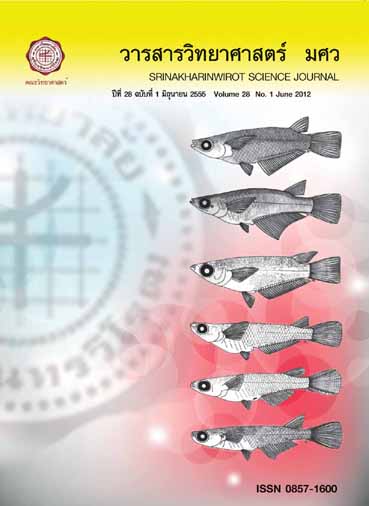ไขมันประจุบวกสำหรับการนำส่งดีเอ็นเอ: โครงสร้างและวิธีสังเคราะห์ (Cationic Lipids for DNA Delivery: Structures and Synthetic Methods)
Keywords:
ยีนบำบัด การนำส่งดีเอ็นเอเข้าสู่เซลล์ การสังเคราะห์ไขมันประจุบวก, gene therapy, transfection, synthesis of cationic lipidAbstract
หลักพื้นฐานของเทคโนโลยียีนบำบัดคือ ระบบการนำส่งดีเอ็นเอเข้าสู่เซลล์เป้าหมาย วิธีการที่มีประสิทธิภาพสูงสุด คือ การใช้พาหะที่เป็นไวรัส ถึงแม้พาหะชนิดไวรัสจะแสดงประสิทธิภาพการนำส่งดีเอ็นเอที่สูง แต่มีข้อจำกัดเนื่องจากผลของภูมิคุ้มกันบกพร่อง พาหะชนิดไม่ใช่ไวรัสสามารถแบ่งเป็น 2 ประเภทหลักคือ วิธีทางฟิสิกส์และวิธีทางเคมี ในบรรดาพาหะชนิดไม่ใช่ไวรัส ไขมันประจุบวกได้รับความสนใจเนื่องจากสามารถเตรียมและพิสูจน์ลักษณะโครงสร้างทางเคมีได้ ไขมันประจุบวกจึงมีบทบาทหลักในการนำส่งดีเอ็นเอเข้าสู่เซลล์และไม่เป็นพิษ ดังนั้นไขมันประจุบวกจึงเป็นทางเลือกหนึ่งสำหรับการนำส่งดีเอ็นเอ สำหรับกลไกการนำส่งดีเอ็นเอยังไม่เป็นที่แน่ชัด แต่เชื่อว่าเป็นแบบเอ็นโดไซโตซิส โดยปกติแล้วโครงสร้างของไขมันประจุบวกประกอบด้วย 3 ส่วนหลักคือ ส่วนหัวที่มีขั้ว ส่วนหางที่ไม่มีขั้ว และส่วนเชื่อมต่อ ในปัจจุบัน นักวิจัยจำนวนมากได้ให้ความสนใจที่จะศึกษา สังเคราะห์และพัฒนาไขมันประจุบวกสำหรับศึกษาการนำส่งดีเอ็นเอเข้าสู่เซลล์The fundamental of gene therapy technology is a DNA delivery system into target cells. The most efficient method for DNA delivery is the use of viral vectors. Eventhough the viral vector exhibited very high transfection efficiency but it has severely limited due to the potential for a specific immune response. Nonviral vector can be classified into two major categories: physical and chemical method. Among the various types of nonviral vectors, cationic lipids are especially attractive as they can be prepared with relative ease and extensively characterized. Cationic lipids play an important role in this method, capable of delivering DNA into cells and nontoxicity. Therefore, these vectors are considered as an alternative for transfecting. The mechanism of DNA intake is not exactly known but is believed to be related to endocytosis. Normally, the structure of cationic lipids compose of three main parts: cationic headgroup, hydrophobic tail and linker. Nowadays, many researchers interest to study, synthesis, and develop the chemistry of cationic lipids for transfection studies.Downloads
Download data is not yet available.
Downloads
Published
2012-06-20
How to Cite
รัชตเวชกุล ว. (2012). ไขมันประจุบวกสำหรับการนำส่งดีเอ็นเอ: โครงสร้างและวิธีสังเคราะห์ (Cationic Lipids for DNA Delivery: Structures and Synthetic Methods). Science Essence Journal, 28(1). Retrieved from https://ejournals.swu.ac.th/index.php/sej/article/view/2226
Issue
Section
บทความวิชาการ








